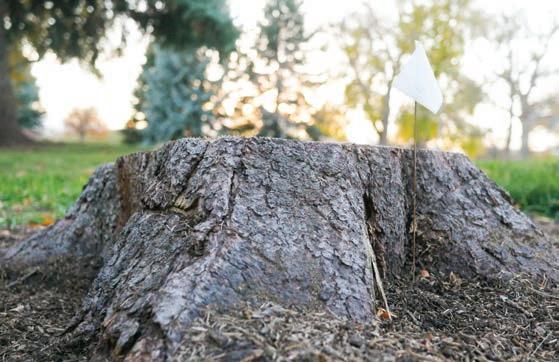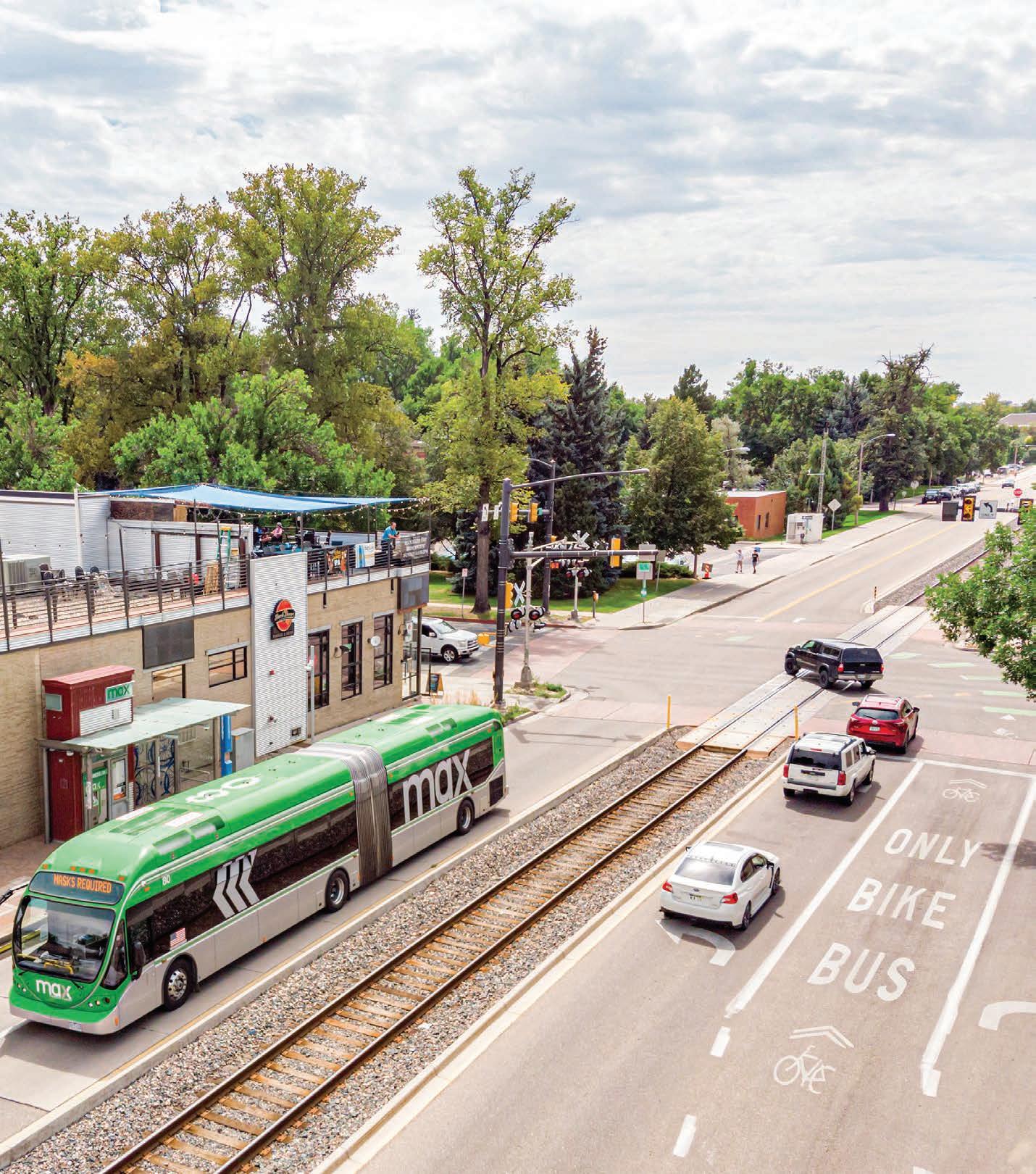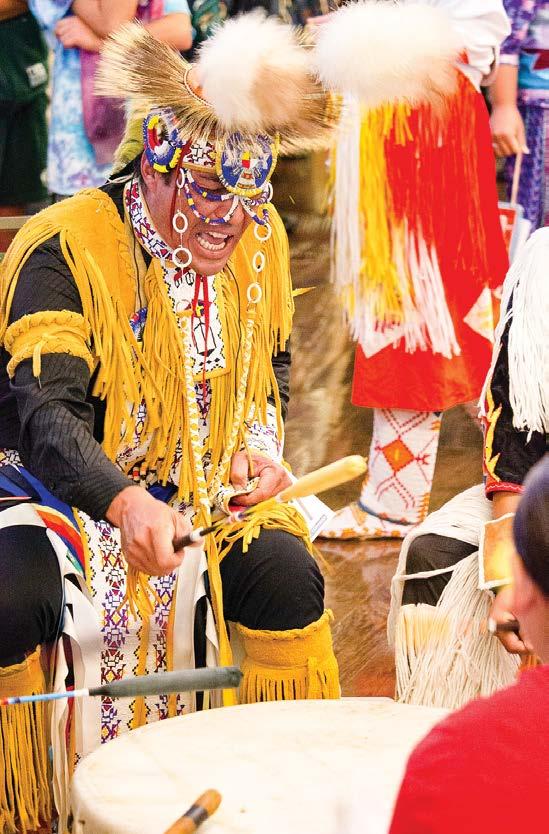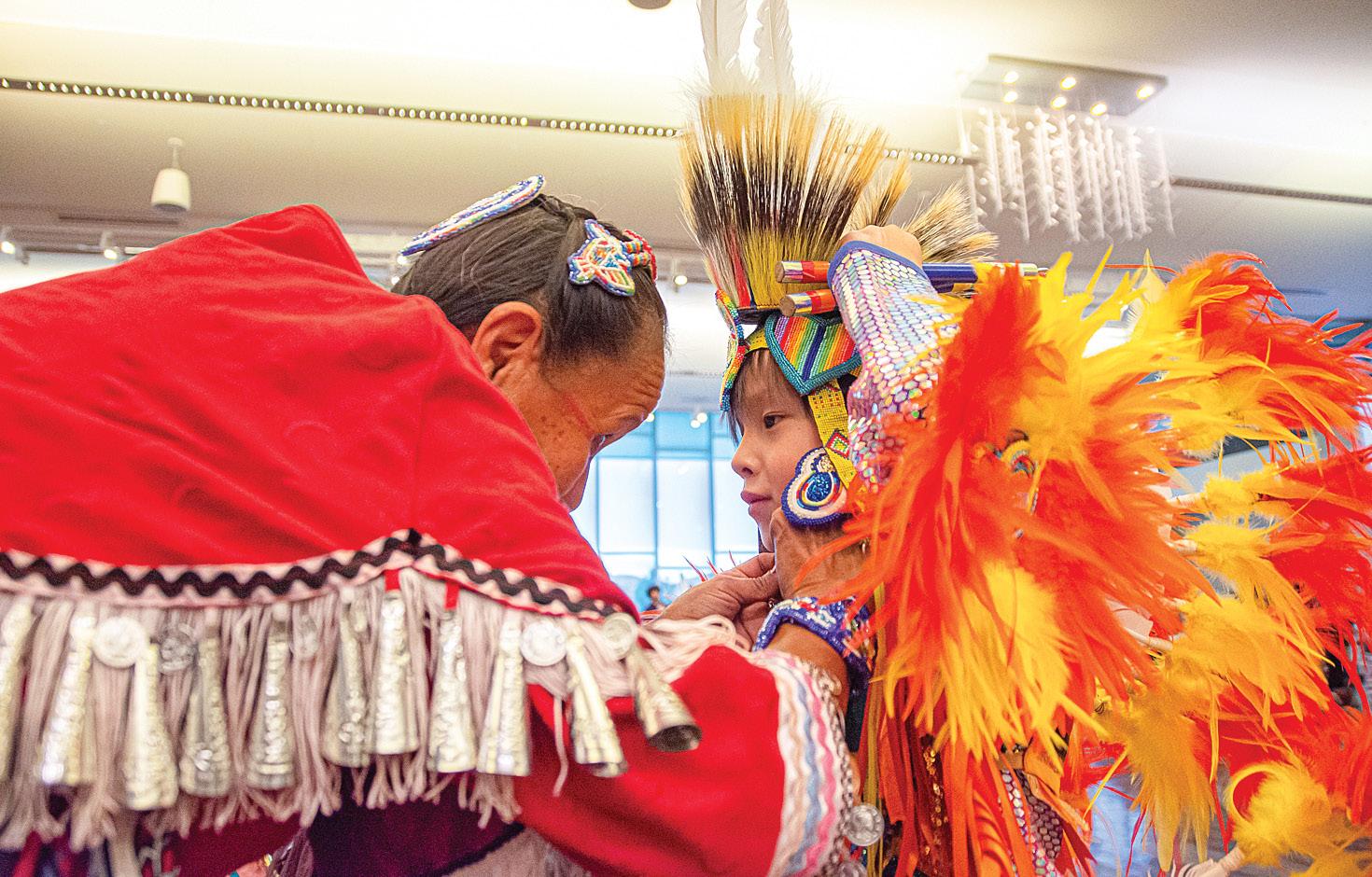
13 minute read
NEWS: Ips beetles cause spikes in spruce tree deaths
CITY
Ips beetles cause spikes in spruce tree deaths
By Miles Buchan
@buchanmiles
Last month, the City of Fort Collins issued a press release warning city residents of “a dramatic increase in spruce tree deaths caused by the ips beetle.” Ips beetles are indigenous to Colorado and are known to inhabit and kill spruce trees.
Among other reasons, the dry, warm and windy weather occurring over the past year has caused the spread of ips beetles in Colorado. Ips beetles attack trees that are experiencing some form of stress and do not typically impact healthy trees. That being said, once a tree is infested with ips beetles, it can be killed relatively quickly.
The ips beetle begins to kill spruce trees from the top down, which is why the top of a spruce tree being dead is the primary way to recognize the presence of ips beetles. Senior Forestry Specialist Carrie Tomlinson said at this stage, an infested tree can be dead within three to six weeks.
Tomlinson stressed the importance of taking action and contacting a licensed arborist or the Fort Collins forestry department as soon as a tree has been infested. Once a tree has become infested with ips, they are liable to spread to surrounding trees, which is why it is important to remove all trees with ips.
Tomlinson said that when an older tree dies, it can often have a large emotional impact on home and property owners.
“Because these are historic trees, it’s very difficult for owners to commit to removal,” Tomlinson said. “They have to figure out emotionally when they’re ready to let trees go.”
Ralph Zentz, assistant city forester with the City of Fort Collins, commented on the timely removal of infested trees as well. Drawing on his 36 years of experience as a member of the forestry department as well as the latest research, Zentz said, “I think a lot of people think they can cure their trees if it has ips, but our research shows that once you see the top die, it’s very unlikely to recover.”
Over this past summer, Tomlinson said the forestry service had to remove 30 medium-to-large trees from public property.
“It’s shocking too because I just moved to Fort Collins,” Tomlinson said. “Seeing big, beautiful trees go is hard.”
The key to preventing ips beetles from killing spruce trees is maintaining trees’ health. Both Zentz and Tomlinson emphasized the importance of watering trees in Fort Collins as much as possible. It is recommended that trees be
CARRIE TOMLINSON
SENIOR FORESTRY SPECIALIST
A spruce tree stump outside the Lory Student Center Lagoon Nov. 9. The tree was cut down because it was infested with ips beetle colonies. Ips beetles, also known as engraver beetles, target pine trees of all varieties but mainly target spruce trees, tunneling through the tree and bark, which kills the tree. PHOTO BY GREGORY JAMES THE COLLEGIAN
watered throughout the year: once per week during the warmer months and twice per month in the colder ones.
Reach Miles Buchan at news@ collegian.com.
CITY
Peace, Love and Little Donuts in Fort Collins closes

Offerings at the Fort Collins Peace, Love and Little Donuts store Oct. 30. The location closed its doors Oct. 31 after five years in operation. PHOTO BY GREGORY JAMES THE COLLEGIAN
By Emmalee Krieg
@csucollegian
After Halloween, it’s hard to tell whether favorite little establishments closing is a trick or just reality.
Nov. 1, the beloved doughnut shop Peace, Love and Little Donuts on South College Avenue closed — meaning one less groovy business on the street.
Peace, Love and Little Donuts, a popular doughnut chain founded in Pittsburgh, Pennsylvania, glazed its way into Fort Collins in 2017. After five years in business, the Fort Collins location closed, leaving Loveland as the only location in Colorado.
According to KUAD-FM Radio, Peace, Love and Little Donuts sent out an email announcing its closure and thanking customers for their support.
“We are sad to announce our Fort Collins Peace, Love and Little Donuts location will be closing for good after normal business hours on October 31,” the email read. “Thank you for your faithful support over the past five years. It has been a true pleasure serving you all.”
“Our main thing is that we just never really financially recovered from COVID, so the store just suffered terribly,” said Abbie Nemes, manager of the shop.
While business wasn’t booming, the employees themselves weren’t given much notice of the shop’s closure.
“I feel like the owner has known about the shop being in trouble for a while, and I feel like it would’ve been something nice to know before we all got hired back on,” Nemes said.
Staff said the announcement of the closure came as a shock and disappointment.
“It affected our staff a lot, especially because we were given a week-and-ahalf notice when the store was going to shut down,” Nemes said. “So a lot of people haven’t been able to find jobs, and nobody’s being transferred over to the store in Loveland.”
“In my interview for this job, I said that I would like a long-term job that I could stay at for a good amount of time, and I was under the impression that that’s the position that I was getting, so it was a surprise for sure,” Peace, Love and Little Donuts staff member Lucia Manier said.
Manier, like several other employees, isn’t prepared for what to do following the closure of the shop.
“A couple of our workers are in high school, so it’s harder for them to find other jobs,” Manier said.
Manier acknowledged the impact of the closure on the community in addition to displaced employees.
“A lot of people are upset — I didn’t realize that we would have that many regulars for a doughnut shop,” Manier said. “A lot of people, especially students, come in here, and it’s a bummer for a lot of them because it’s a nice little spot.”
The Loveland location of Peace, Love and Little Donuts has been open since 2019 and will continue normal operations.
“I hope that our shop made good impact on Old Town,” Nemes said. “I feel like a lot of people really did love this store, even though we didn’t really get the best business over the last year.”
Reach Emmalee Krieg at news@ collegian.com.
LUCIA MANIER
PEACE, LOVE AND LITTLE DONUTS STAFF MEMBER
CAMPUS
ATFAB increases equity focus for student-funded projects
By Jordan Mahaffey
@_mahaffeyjordan
Members of Colorado State University’s Alternative Transportation Fee Advisory Board have put in efforts to ensure projects funded by the board are more equitable and valuable to students.
According to ATFAB’s website, the board provides guidance and advice to the president of the Associated Students of Colorado State University and the alternative transportation manager about CSU’s contract with Transfort and other transportation needs. The board also oversees the allocation of funding from the $33.65-per-person alternative transportation fee paid by fulltime on-campus students for projects proposed to the board, all with the goal of providing or improving transportation facilities for CSU students.
“A big part of what ATFAB does is oversee the contracts that the university has with Transfort,” said Kenneth Kinneer, ATFAB financial board member. “That’s a large chunk of our budget that goes toward that contract. The board manages the alternative transportation fee that students pay, … and that goes toward the contract, new infrastructure projects and programs.”
The programs funded by ATFAB are decided by the board during the spring, and in the fall, the board focuses on evaluating how the award funds are used and updating the project application, explained Aaron Fodge, ATFAB advisor and alternative transportation manager for CSU’s Parking and Transportation Services.
Project applications are linked on ATFAB’s website and are due Jan. 20, 2023.

ATFAB accepts two different kinds of project proposals.
“We have programmatic projects and infrastructure projects,” said Helen Flynn, ATFAB chairperson. “The programmatic projects are things like The Spoke, Rams Ride Right and SkiSU. ... The infrastructure projects are things like the bike roundabout inbetween the (Lory Student Center) and the library, Hughes Way and the Monfort Quad (Crossing) Trail.”
Other projects funded by the board are listed on the Funded Projects page of its website.
The board decides on the allocation of funds based on the project rating criteria they release.
“We go back and look to see what the current year’s board would like to change, and we release our application with the new, updated scoring criteria,” Flynn said. “That is basically so that we have a consistent metric used for each project.”
One of the changes made by the board this year was to put a bigger emphasis on equity.
“We have kind of a renewed focus on equity considerations and the way that we evaluate projects,” Kinneer said. “We, the board, have now updated our scoring criteria to reflect a greater commitment to bringing value to students and meeting the needs of the CSU community. Ensuring that we fund projects that are safe, impactful and equitable are some of our most important considerations.”
In addition to putting a focus on equity in their scoring criteria, ATFAB is also taking lengths to incorporate diversity, equity and inclusion in the board itself.
“It’s important for the board to have representation across all the college councils,” Fodge said. “It also has representatives from ASCSU and the (CSU Graduate Student Council). This is a fee board that is taking an allocation of students and fees and representing them. It’s used in a fair and equitable manner to award transportation projects on campus for the benefit of students.”
“We are really trying to diversify the board and increase our cultural awareness and competency,” Flynn said. “I think that (diversity, equity and inclusion) is becoming a really important thing, especially for a board that’s representing the university. We can’t have a room of people who all look the same, and so we have done our best to recruit diverse members, but to make up for what we may be lacking in and some opinions that we may be missing out on, we are going to have some diversity trainings and a presentation from diversity professionals.”
Currently, the board is working on providing transportation to and from the University Center for the Arts.
“As it stands, there really isn’t that transportation infrastructure for students,” Kinneer said. “It’s a concern because you’d have musicians with heavy instruments who are forced to essentially walk under the … underpass that leads to the CSU flower gardens and then on to the UCA. ... We’re considering going with a third-party company to provide that shuttling service. It’s not set in stone yet.”
Reach Jordan Mahaffey at news@ collegian.com.
HELEN FLYNN
ALTERNATIVE TRANSPORTATION FEE ADVISORY BOARD CHAIR
COVER STORY
Traditions return in person at AISES 38th annual pow wow
By Ivy Secrest
@ivysecrest

The Native American Cultural Center and the American Indian Science and Engineering Society at Colorado State University held the 38th annual pow wow in the Lory Student Center Nov. 5.
For coordinators like Miya Chavez, president of AISES, the role the pow wow plays in the broader CSU community is essential. It elevates representation and visibility.
“I think a lot of people don’t see us as real, modern people,” Chavez said. “Just because we’ve held on to our traditions and our old ways of life doesn’t mean that we are completely out of the loop. We still have jobs, we still have phones, we still have everything that a white person would have; it’s just we’re essentially a product of assimilation.”
Even the location of this event — being at the land-grant institution that CSU is — made this assimilation apparent. However, many traditions have held strong, and over the past 38 years, the pow wow on campus has become its own tradition.
From the ground blessing and intertribal dancing and singing to the flatbread served and the vendors present, the event encompassed the community.
Reconnecting as a community was important to many attendees, especially considering how the COVID-19 pandemic disproportionately affected Indigenous communities. Many attendees were excited to return to socialize and experience community support; however, not all community members were able to return for this year’s pow wow.
“It’s sad because some people didn’t make it,” said Doug Good Feather, the spiritual consultant who performed the ground blessing and executive director of the Lakota Way Healing Center. “But I’m really thankful that we’re getting back to life again. We’re starting to move again.”

Dance is a big part of the pow wow, and this year’s dancers came to share this tradition with family members. Sunshine Sweetwater, a jingle dress dancer of the Navajo, Cheyenne and Osage tribes, came to the pow wow to dance with her mother and children.
“I get to show my kids their culture,” Sweetwater said. “Educate them, make them belong and feel like they belong. It can be passed down from generation to generation.”
Sweetwater said she was excited to be back and socializing since the inperson events have such a different energy. She has been dancing since she could walk, and these events are a huge part of her life.
“I feel like people kind of forget about Native American culture,” Sweetwater said. “They don’t really recognize it until November. And then everybody starts (to) talk about it for a month — then it’s gone again, like a repeated cycle. It’s so good to see non-Natives come to these events too. They get to get a sense of what we do, … how we’re connected to Mother Earth and the land and all of our culture.”
As families prepared for the dances, mothers like Sweetwater braided their children’s hair, and siblings wandered the LSC ballroom holding hands to stick together until it was their turn to dance.
“Even if they’re half or quarter, that’s part of who you are,” Sweetwater said. “Your ancestors, they had to survive for you to be here.”
Identity and what ties people to the Indigenous community are exemplified even in the titles people hold in the pow wow.
“In our culture, you can’t go around claiming you’re something that you’re not,” Good Feather said. “It’s the people who will give you that title in that respect. They call me the spiritual leader/advisor, and I just walked my life regular.”
Good Feather said it was important for this country to remember that Indigenous peoples are a huge part of the United States’ history — that they are the founders, and this is their home. He said he was grateful to those who took the time to organize this and appreciate their families, their histories and their culture.
“We’ve got to remember to keep moving forward,” Good Feather said. “It’s important for us to come together and see each other. You acknowledge each other and just realized we’re all on the same path. And we’re all human beings, and we’re no different.”
Reach Ivy Secrest at life@ collegian.com.
SUNSHINE SWEETWATER
JINGLE DRESS DANCER OF THE NAVAJO, CHEYENNE AND OSAGE TRIBES
Elvira Sweetwater and Midnight Sweetwater of the Navajo Nation prepare to participate in a kids-only traditional dance during the 38th annual American Indian Science and Engineering Society Pow Wow in the Lory Student Center Grand Ballroom Nov. 5. PHOTO BY TRI DUONG THE COLLEGIAN
Desmond Big Eagle from the Rosebud Reservation in South Dakota participates in a drum circle during the 38th annual American Indian Science and Engineering Society Pow Wow in the Lory Student Center Grand Ballroom Nov. 5.
PHOTO BY ANDREW TREVINO
THE COLLEGIAN








